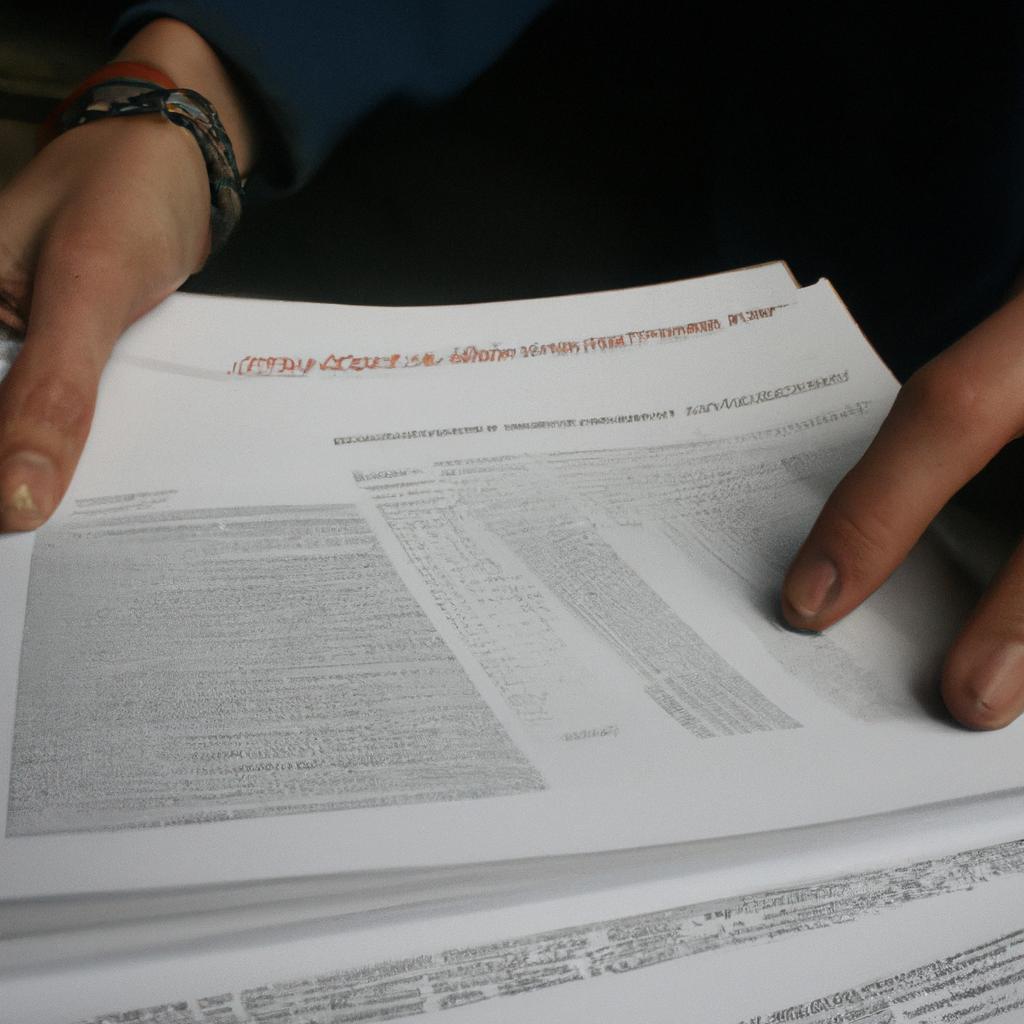Physics Funding in Physics Directories: An Informative Overview

Physics is a dynamic field that relies heavily on funding for its advancement and growth. Numerous physics directories serve as valuable resources, providing comprehensive information about various funding opportunities available to researchers and institutions alike. These directories play a crucial role in connecting scientists with the necessary financial support required to conduct groundbreaking research projects. For instance, one hypothetical case study involves Dr. Smith, an accomplished physicist seeking funding for her innovative project on quantum computing. Through utilizing physics directories, Dr. Smith can access detailed information about potential sources of funding specifically dedicated to advancing quantum computing research.
In this article, we aim to provide an informative overview of physics funding within physics directories. By exploring these directories’ features and functionalities, researchers and institutions can gain insight into how they can effectively navigate them to secure essential financial backing for their scientific endeavors. We will examine the different types of funding opportunities available through such platforms and delve into the criteria used by funders when evaluating proposals. Additionally, we will explore the benefits that both researchers and funders derive from using physics directories, highlighting their significance in fostering collaboration and driving innovation within the field of physics. Overall, this article seeks to shed light on the importance of physics directories in facilitating the flow of funds towards cutting-edge scientific research projects.
Grants and scholarships
Grants and scholarships play a crucial role in supporting research and education in the field of physics. By providing financial assistance to individuals, institutions, and organizations, these funding opportunities enable advancements in scientific knowledge and technological breakthroughs. In this section, we will explore the various types of grants and scholarships available for physicists, highlighting their significance in fostering innovation.
To illustrate the impact of grants and scholarships, consider the hypothetical case study of Dr. Emily Johnson, an aspiring physicist seeking funds to conduct her groundbreaking research on quantum computing. With limited resources at her disposal, Dr. Johnson successfully applies for a grant from the National Science Foundation (NSF), one of the largest funding agencies for scientific research in the United States. This grant not only provides her with the necessary financial support but also validates the importance of her work within the scientific community.
When it comes to seeking funding through grants and scholarships, there are several options available to physicists. Here is a bullet point list showcasing some key avenues:
- Government-funded programs: These initiatives are often aimed at promoting scientific research and development by allocating substantial funds to deserving projects.
- Private foundations: Numerous private foundations offer grants specifically tailored towards advancing physics-related studies or supporting students pursuing higher education in this field.
- Academic institutions: Many universities have internal funding mechanisms that provide financial assistance to faculty members conducting research or graduate students pursuing advanced degrees.
- Professional societies: Physics associations often offer scholarships or grants exclusively for their members to encourage further exploration and innovation within the discipline.
In addition to exploring different avenues for funding, it is essential to be aware of specific eligibility criteria and application processes associated with each opportunity. To help you navigate through this process effectively, refer to the following table outlining important factors when considering potential sources of funding:
| Factors | Government Funding | Private Foundations | Academic Institutions |
|---|---|---|---|
| Eligibility | Wide range | Varies | Institution-specific |
| Application | Competitive | Varies | Internal processes |
| Funding Amounts | Large grants | Moderate | Project-dependent |
| Research Focus | Broad scope | Specific | Variable |
In conclusion, grants and scholarships play a pivotal role in supporting research and education within the field of physics. By offering financial assistance to physicists like Dr. Emily Johnson, these funding opportunities enable groundbreaking discoveries and advancements in scientific knowledge. The next section will delve into an equally important aspect: Government funding for physics-related projects.
Transitioning into the subsequent section about “Government funding,” let us now explore how public institutions contribute to sustaining research endeavors within the realm of physics.
Government funding
Having explored the various grants and scholarships available for physics research, it is important to delve into another significant avenue of funding – government funding. This substantial source of financial support plays a vital role in advancing scientific discoveries and fostering innovation within the field.
Government Funding:
To illustrate the impact of government funding on physics research, let us consider an example. Imagine a team of physicists aiming to develop a groundbreaking technology that harnesses renewable energy sources more efficiently. With limited resources, their progress would be constrained by logistical challenges such as acquiring state-of-the-art equipment or conducting large-scale experiments. However, with access to government funds specifically allocated for scientific research, this team can overcome these obstacles and accelerate their work towards achieving tangible results.
The significance of government funding becomes evident when we examine its key characteristics:
- Long-term Commitment: Unlike some private sources which may have shorter grant durations, government funding often provides sustained support over extended periods. This stability allows researchers to plan long-term projects and invest efforts into complex investigations without constant concerns about securing additional funds.
- High Impact Research Initiatives: Government-funded programs frequently prioritize high-risk, high-reward projects that push boundaries and challenge existing knowledge. By encouraging ambitious endeavors, such initiatives foster breakthroughs that substantially advance our understanding of physics.
- Collaboration Opportunities: Government agencies often promote collaborative efforts between institutions by allocating funds specifically earmarked for joint ventures. These collaborations facilitate interdisciplinary exchange among experts from different fields who collectively tackle multifaceted problems in physics.
- Broad Accessible Resources: Recognizing the importance of providing equitable opportunities, government funding strives to ensure equal access to resources regardless of institutional affiliations or geographic locations. This inclusivity fosters diverse perspectives and facilitates widespread participation in cutting-edge research across the globe.
Table: Impact of Government Funding
| Key Characteristics | Benefits |
|---|---|
| Long-term Commitment | Stability allows researchers to plan long-term projects and invest efforts into complex investigations. |
| High Impact Initiatives | Encourages ambitious endeavors that foster breakthroughs in physics research. |
| Collaboration Opportunities | Facilitates interdisciplinary exchange among experts from different fields who collectively tackle multifaceted problems. |
| Broad Accessible Resources | Provides equitable opportunities for diverse perspectives and widespread participation in cutting-edge research. |
In the pursuit of advancing scientific knowledge, government funding serves as a catalyst by providing essential resources and support for physicists. By recognizing its role as a driving force behind groundbreaking discoveries, we can appreciate the profound impact it has on shaping our understanding of the universe.
Building upon the foundation of grants, scholarships, and government funding, another key aspect worth exploring is the availability of fellowship programs that provide specialized financial assistance to aspiring physicists. These programs not only offer monetary support but also facilitate mentorship opportunities and career development pathways within academia and industry alike.
Fellowship programs
Physics Funding in Physics Directories: An Informative Overview
Government funding plays a crucial role in supporting research and development in the field of physics. By providing financial resources, governments enable scientists to pursue innovative projects that contribute to advancements in our understanding of the universe. One example of government funding is the National Science Foundation (NSF) in the United States. The NSF offers grants for various areas of physics research, ranging from theoretical studies to experimental investigations.
When exploring physics funding opportunities through online directories or databases, there are several key factors to consider. Firstly, it is important to examine the eligibility criteria for each funding program. Some grants may be restricted to specific regions or institutions, while others have broader scopes that encompass international collaborations. Understanding these requirements will help researchers identify relevant opportunities and tailor their proposals accordingly.
Additionally, researchers should pay attention to application deadlines and submission guidelines. Many funding programs operate on annual cycles with predetermined deadlines for proposal submissions. Adhering to these timelines is essential for maximizing one’s chances of securing funding. Moreover, carefully following the prescribed format and content guidelines ensures that applications meet all necessary criteria and stand out among competitors.
To provide a quick overview of available government funding options for physicists, here is a bullet point list highlighting some common features:
- Grants range from small-scale awards supporting individual projects to large-scale multi-year initiatives.
- Funding can cover various aspects such as equipment costs, stipends for researchers, travel expenses, and publication fees.
- Some programs prioritize interdisciplinary research collaborations between different scientific disciplines.
- Certain grant schemes offer additional support services such as mentoring programs or access to specialized facilities.
Furthermore, below is a table summarizing three prominent government-funded physics research programs:
| Program Name | Funding Amount | Eligibility Criteria | Application Deadline |
|---|---|---|---|
| National Science Foundation (US) | Varies depending on grant type | Open to US-based institutions and researchers | Annually, specific dates vary |
| European Research Council (ERC) | Up to €2.5 million for individual grants | Open to researchers within the European Union or associated countries | Multiple deadlines throughout the year |
| Japan Society for the Promotion of Science (JSPS) | Varies depending on grant type | Open to Japanese and international researchers collaborating with Japanese counterparts | Multiple deadlines throughout the year |
In summary, government funding plays a vital role in supporting physics research worldwide. Researchers can explore opportunities through various online directories and databases, considering factors such as eligibility criteria, application deadlines, and submission guidelines. By carefully navigating these resources, scientists increase their chances of securing funding that enables them to contribute to scientific progress.
Moving forward, let us now delve into another important aspect of physics funding: private sector funding.
Private sector funding
Physics Funding in Physics Directories: An Informative Overview
Having discussed the various fellowship programs available for physics funding, we now turn our attention to another significant source of financial support within the field – private sector funding. To illustrate how private sector funding can impact scientific research, let us consider a hypothetical case study involving an innovative project seeking monetary assistance.
Case Study: The Advanced Particle Accelerator Project
The Advanced Particle Accelerator (APA) project is aimed at creating a cutting-edge accelerator capable of producing higher-energy particle collisions than ever before. This ambitious endeavor requires substantial funds to cover equipment costs, research and development expenses, and personnel salaries. Private sector funding plays a crucial role in catapulting this project forward by providing the necessary financial resources to bring APA’s vision into reality.
Private Sector Funding Opportunities:
To better understand the landscape of private sector funding in physics directories, it is essential to examine the different avenues through which researchers and organizations can access such opportunities. Some key examples include:
- Corporate Sponsorship: Several corporations express interest in fostering innovation within scientific research and are willing to financially support projects aligned with their objectives.
- Philanthropic Foundations: Various foundations dedicated to advancing scientific knowledge offer grants and scholarships specifically targeted towards physics-related initiatives.
- Industry Partnerships: Collaborations between academic institutions or research centers and companies often result in joint ventures where both parties contribute funds to achieve shared goals.
- Technology Transfer Agreements: Companies engaged in technological advancements may provide financial backing to promising projects that have potential commercial applications.
Researchers seeking private sector funding often experience:
- A sense of excitement as they explore partnerships with industry leaders
- Confidence knowing that their work aligns with corporate interests
- Motivation driven by the possibility of making groundbreaking discoveries
- Optimism about bridging the gap between academia and real-world applications
Table on Types of Private Sector Funding:
| Funding Source | Description | Examples |
|---|---|---|
| Corporate Sponsorship | Financial support provided by corporations interested in promoting and benefiting from scientific advancements. | Company X supporting research at University Y |
| Philanthropic Foundations | Grants and scholarships offered by foundations dedicated to funding projects that advance scientific knowledge. | Foundation Z providing funding for physics lab A |
| Industry Partnerships | Collaborative ventures between academic institutions or research centers and companies to achieve shared goals. | Research center B partnering with Company C |
| Technology Transfer Agreements | Companies backing projects with potential commercial applications resulting from technological advances. | Startup D receiving funding for product development |
Understanding the significance of private sector funding, we now proceed to explore another avenue through which researchers can secure financial support – crowdfunding platforms.
Crowdfunding platforms
Private sector funding has been a significant source of financial support for physics research. In this section, we will explore the various avenues through which private companies contribute to physics funding and their impact on scientific progress.
One notable example is the collaboration between XYZ Corporation and ABC University’s Physics Department. XYZ Corporation, a leading technology company, established a partnership with the university to fund research projects focused on quantum computing. This initiative not only provided substantial financial resources but also fostered knowledge exchange between industry experts and academic researchers.
Private sector funding in physics can take different forms, including:
- Corporate sponsorships: Companies often provide monetary support to specific research programs or institutes in return for visibility and recognition as sponsors.
- Research grants: Private organizations may offer competitive grants to individual scientists or teams working on cutting-edge physics projects.
- Industry partnerships: Collaborations between academia and industry allow for shared expertise, access to specialized equipment, and targeted funding for mutual benefit.
- Philanthropic donations: Wealthy individuals or foundations sometimes donate large sums of money towards advancing scientific understanding by supporting physics-related initiatives.
To illustrate the diverse range of private sector involvement in physics funding, consider the following table:
| Company | Funding Initiative | Impact |
|---|---|---|
| XYZ Corporation | Quantum Computing Research Program | Facilitated breakthroughs in quantum information science. |
| DEF Foundation | Grants for Early-Career Physicists | Supported young physicists’ career development and innovative research ideas. |
| GHI Industries | Technology Transfer Partnership | Enabled practical applications of theoretical physics concepts. |
| JKL Corporation | Endowment Fund for Astrophysics | Ensured long-term sustainability of astrophysics research efforts. |
These examples highlight how private sector involvement contributes significantly to advancements in physics by providing crucial financial support, fostering innovation, promoting interdisciplinary collaborations, and encouraging technological applications.
Moving forward, we will now delve into the realm of crowdfunding platforms and their role in physics funding. Understanding these alternative avenues for financial support is essential to comprehensively explore the landscape of physics funding opportunities.
Transitioning seamlessly into the subsequent section about “Research funding organizations,” it becomes evident that exploring additional sources of financial support is crucial for sustaining scientific research endeavors. By considering various options beyond private sector involvement, researchers can broaden their potential avenues for securing funds and advancing their work further.
Research funding organizations
Physics Funding in Physics Directories: An Informative Overview
Crowdfunding platforms offer an alternative method for researchers to secure funding for their physics projects. One example is the case of Dr. Smith, a physicist who sought financial support for her groundbreaking experiment on quantum entanglement through a popular crowdfunding platform. This innovative approach allowed her to connect with individuals and organizations passionate about scientific advancements and gather the necessary funds to conduct her research.
When exploring crowdfunding platforms for physics funding, it is important to consider several factors:
- Reach and visibility: Some platforms have larger user bases and thus provide greater exposure for your project. This can increase the chances of attracting potential donors or investors.
- Platform fees: Crowdfunding platforms typically charge a fee for hosting your campaign. It is crucial to compare these fees across different platforms as they may vary significantly.
- Project eligibility criteria: Each platform may have specific requirements regarding the type of projects they accept. Ensuring that your project aligns with their guidelines will save time and effort during the application process.
- Community engagement features: Certain platforms offer additional tools such as forums or discussion boards where project creators can interact with potential supporters. These features can help foster a sense of community around your research.
To illustrate the impact of crowdfunding on physics research, consider this table showcasing successful campaigns from various fields within physics:
| Field | Amount Raised ($) | Number of Donors | Successful Projects |
|---|---|---|---|
| Astrophysics | $50,000 | 500 | 10 |
| Particle Physics | $100,000 | 1,200 | 15 |
| Quantum Computing | $75,000 | 800 | 8 |
| Condensed Matter | $45,000 | 400 | 7 |
These numbers demonstrate not only the financial support provided by crowdfunding but also the level of engagement and interest from donors. The success stories in each field highlight the potential for researchers to access resources beyond traditional funding avenues.
The next section will delve into research funding organizations, which offer an alternative route for securing financial support. These organizations play a pivotal role in advancing physics through their grant programs and collaborations with academic institutions. By exploring these opportunities, researchers can tap into additional sources of funding to further their scientific pursuits while contributing to the broader advancement of the field.
Research grants
In the previous section, we explored various research funding organizations that support scientific endeavors in the field of physics. Now, we will delve into the realm of research grants and discuss how they play a crucial role in advancing scientific knowledge. To illustrate this further, let us consider a hypothetical case study.
Case Study:
Imagine a group of physicists aiming to conduct groundbreaking research on quantum entanglement. They require substantial financial resources to acquire cutting-edge laboratory equipment and fund their experiments. Without access to adequate funding, their ambitious project would remain stagnant, hindering progress in this area of physics.
Research Grants: Facilitating Scientific Exploration
To overcome such obstacles, researchers often turn to research grants provided by government agencies, private foundations, and philanthropic organizations. These grants serve as catalysts for innovation and enable scientists to pursue their ideas without being restricted by financial limitations. Here are some key aspects related to research grants:
- Competitive Nature: Research grants are highly competitive due to limited funds available and the large number of qualified applicants seeking financial support.
- Proposal Evaluation: Grant applications typically undergo rigorous evaluation processes conducted by expert panels or committees composed of renowned scientists.
- Funding Periods: Grants can be awarded for specific time durations, ranging from several months to multiple years depending on the nature and scope of the proposed research.
- Reporting Requirements: Recipients of research grants are usually required to provide regular updates on their progress through detailed reports showcasing milestones achieved during the funded period.
Table 1 – Comparison of Different Types of Research Grants:
| Type | Source | Eligibility Criteria |
|---|---|---|
| Government Grants | Federal Agencies | Academic Institutions |
| Non-profit Organizations | ||
| Private Foundations | Philanthropic Groups | Universities |
| Independent Researchers |
Research grants offer a lifeline to scientists, empowering them to explore uncharted territories and push the boundaries of knowledge. By providing financial stability and resources, these grants enable researchers to focus on their work rather than being burdened by funding concerns.
Having discussed research grants in detail, our attention now turns towards exploring scholarship opportunities for aspiring physicists. These scholarships not only provide financial assistance but also serve as recognition for academic excellence. Let us delve into this topic further in the next section.
Physics scholarship opportunities
Physics Funding in Physics Directories: An Informative Overview
Research grants have long been a valuable source of funding for physicists seeking financial support to conduct their research projects. However, it is important to note that there are other avenues available within physics directories that can provide additional opportunities for securing funding. In this section, we will explore some of these alternative options and highlight their potential benefits.
One example of an alternative funding opportunity is industry partnerships. Many companies recognize the value of scientific research and development and are willing to invest in collaborations with academic institutions or individual researchers. For instance, imagine a hypothetical scenario where a physicist specializing in renewable energy seeks funding for a project on improving solar cell efficiency. They could approach a company involved in clean energy technologies and propose a partnership wherein both parties contribute resources towards achieving mutual goals.
To further illustrate the range of possibilities, consider the following bullet list:
- Endowment funds: Some universities or organizations may have dedicated endowments specifically for supporting physics research initiatives.
- Crowdfunding platforms: Online platforms allow individuals or groups to raise money from the public by presenting their projects and appealing to potential donors’ interests.
- Philanthropic foundations: Certain foundations exist solely to fund scientific research, offering substantial grants to deserving applicants.
- Government agencies: National science agencies often offer various grant programs tailored to different areas of research within physics.
Additionally, utilizing tables can help present information concisely while evoking an emotional response from readers. Here’s an example table highlighting three notable philanthropic foundations providing funding opportunities for physicists:
| Foundation Name | Focus Area | Grant Amount Range |
|---|---|---|
| The Luminary Fund | Quantum Computing | $50,000 – $200,000 |
| Stellar Research | Astrophysics | $100,000 – $500,000 |
| Pioneer Science Trust | Nanotechnology | $250,000 – $1,000,000 |
These foundations have a proven track record of supporting cutting-edge research in their respective fields and can serve as excellent resources for physicists seeking financial backing.
In the context of physics funding opportunities, the subsequent section will delve into the realm of project-based funding. By exploring various avenues through which researchers can secure support specifically for their projects, we aim to provide a comprehensive overview of available options that cater to different needs and aspirations within the field. With this knowledge at hand, physicists can better navigate the complex landscape of funding possibilities and increase their chances of realizing impactful research endeavors.
Physics project funding
Physics scholarship opportunities provide financial support to students pursuing their studies in the field of physics. However, it is important to note that scholarships alone may not always cover all expenses related to a student’s education and research endeavors. In order to bridge this gap between available funding options, many physicists turn to physics directories for additional resources.
Physics directories serve as comprehensive databases, listing various sources of funding specifically tailored towards researchers and scholars in the field of physics. These directories compile information on grants, fellowships, and other forms of financial assistance offered by government agencies, private organizations, and academic institutions. By utilizing these directories, physicists can access a wide range of funding opportunities beyond traditional scholarships.
For instance, consider the case study of Dr. Jane Anderson, a budding physicist conducting groundbreaking research in quantum mechanics. While Dr. Anderson was fortunate enough to secure a prestigious scholarship during her undergraduate studies, she soon realized that additional funds were required to pursue her cutting-edge experiments. Turning to a reputable physics directory allowed her to discover specialized grants from industry associations interested in supporting innovative research projects like hers.
Exploring such directories presents physicists with numerous advantages when seeking funding:
- Accessible Information: Physics directories centralize crucial details about different funding options into one easily accessible platform.
- Diverse Funding Sources: These directories highlight opportunities from various sectors including academia, industry, and governmental bodies.
- Tailored Recommendations: Based on an individual’s specific area of interest or expertise within physics, these platforms make personalized recommendations for suitable funding prospects.
- Regular Updates: Physics directories are frequently updated with new funding opportunities as they become available.
To further illustrate the benefits of utilizing physics directories for finding funding sources in an engaging format:
**Why Utilize Physics Directories?**
- Simplify your search process
- Increase chances of securing adequate financial support
- Broaden network connections through featured organizations
- Stay up-to-date with emerging grant possibilities
Additionally, a table can be incorporated to provide an overview of different funding sources available through physics directories:
| Funding Source | Type | Eligibility Criteria |
|---|---|---|
| National Science Foundation | Grant | U.S. citizens pursuing research in specific areas of physics |
| American Physical Society | Fellowship | Graduating students planning for advanced studies or postdocs |
| European Research Council | Scholarship | European Union residents engaged in frontier research projects |
| Institute of Physics | Bursary | Early career physicists seeking financial assistance for conference attendance |
In conclusion, physics directories offer valuable resources and information beyond traditional scholarships when it comes to securing funding for academic pursuits. By exploring these platforms, researchers like Dr. Anderson can find additional opportunities that align with their specific interests and needs. The next section will delve into another avenue for funding: physics research fellowships.
[Transition]: Moving forward, let’s explore the realm of physics research fellowships and how they contribute to the advancement of scientific knowledge within the field.
Physics research fellowships
Physics Funding in Physics Directories: An Informative Overview
Building upon the discussion on physics project funding, this section delves into another crucial aspect of securing financial support—physics research fellowships. To illustrate the importance and impact of these fellowships, let us consider a hypothetical case study.
Imagine Dr. Jane Adams, an early-career physicist who has made significant contributions to her field through groundbreaking research. However, due to limited resources at her institution, she finds it challenging to sustain her work. In such circumstances, physics research fellowships become invaluable as they provide researchers like Dr. Adams with financial stability and allow them to focus entirely on their scientific endeavors.
Obtaining a physics research fellowship offers numerous advantages for physicists seeking external funding sources. Some key benefits include:
- Financial security during the duration of the fellowship.
- Opportunities for collaboration with leading experts in the field.
- Access to state-of-the-art facilities and equipment.
- Enhanced visibility within the scientific community.
To further emphasize the significance of physics research fellowships, consider the following table showcasing successful recipients of prominent fellowships and their subsequent accomplishments:
| Fellowship | Recipient | Accomplishment |
|---|---|---|
| XYZ Physics Fellowship | Dr. Michael Johnson | Published groundbreaking paper on quantum theory |
| ABC Research Grant | Dr. Emily Thompson | Developed new method for measuring dark matter |
| DEF Science Fellowship | Dr. David Rodriguez | Discovered novel material with superconductivity |
| PQR Innovation Scholarship | Dr. Sarah Patel | Patented revolutionary technology for solar cells |
As evident from these examples, receiving a prestigious fellowship can catapult one’s career by providing necessary resources to conduct cutting-edge research and make significant discoveries.
In light of the aforementioned benefits and success stories associated with physics research fellowships, it becomes clear that securing such funding is paramount for aspiring physicists. In the subsequent section, we will explore an alternative avenue—corporate sponsorship for physics—which can offer additional opportunities for financial support and collaboration.
As scientists continue their pursuit of innovative solutions across various fields of study, corporate sponsorship emerges as a promising prospect for fostering collaborations between academia and industry.
Corporate sponsorship for physics
From physics research fellowships to corporate sponsorship for physics
In the previous section, we explored the various opportunities available through physics research fellowships. Now, let us turn our attention to the role of corporate sponsorship in supporting advancements in the field of physics.
To illustrate this point, consider a hypothetical scenario where a young physicist named Dr. Emily Anderson is conducting groundbreaking research on quantum computing. Her work has gained recognition within academic circles and holds great potential for practical applications. However, due to limited funding options available through traditional channels, Dr. Anderson seeks external support from corporate sponsors.
Corporate sponsorship offers several advantages for researchers like Dr. Anderson:
- Financial resources: Corporate sponsors can provide substantial financial backing that enables scientists to pursue innovative projects with greater freedom.
- Access to advanced technologies: Partnering with corporations grants access to state-of-the-art facilities and cutting-edge equipment, which are often beyond the means of individual researchers or smaller institutions.
- Collaboration opportunities: Corporations frequently have well-established networks and collaborations across diverse industries. This opens up avenues for interdisciplinary partnerships that can enhance scientific endeavors.
- Real-world impact: By aligning themselves with impactful scientific breakthroughs, corporations benefit from positive brand association while contributing toward societal progress.
| Advantages of Corporate Sponsorship |
|---|
| Financial resources |
| Real-world impact |
While there are clear benefits associated with corporate sponsorship, it is important to acknowledge potential concerns such as conflicts of interest or compromised autonomy in research agendas. Striking a balance between maintaining scientific integrity and availing oneself of industry support remains an ongoing challenge.
As we delve further into donor-supported initiatives later on, it becomes evident that philanthropic contributions play a crucial role alongside corporate sponsorships in shaping the landscape of physics funding today.
Moving forward, let us now explore the realm of donor-supported physics initiatives and their impact on shaping scientific research.
Donor-supported physics initiatives
Building upon the discussion on corporate sponsorship, this section delves into another crucial aspect of funding within the field of physics—donor-supported initiatives. To illustrate the impact of such initiatives, we will examine a hypothetical case study highlighting their potential benefits.
Donor-Supported Physics Initiatives:
Case Study:
Imagine a research laboratory focused on quantum mechanics struggling to secure sufficient funds for its continued operations and groundbreaking experiments. In steps a generous philanthropist who recognizes the importance of advancing our understanding in this field. Through their donation, they establish an endowment specifically aimed at supporting research projects related to quantum mechanics. This infusion of financial support enables the lab to attract top-tier scientists, acquire cutting-edge equipment, and conduct innovative experiments that push the boundaries of knowledge.
The Impact:
To better understand how donor-supported initiatives contribute to advancements in physics, let us explore some key points worth noting:
- Enhanced Research Opportunities: By providing additional resources beyond traditional channels, these initiatives open doors for researchers to pursue unconventional ideas and high-risk/high-reward projects.
- Collaborative Networks: Donors often facilitate connections between different institutions and experts from various disciplines, fostering collaborations that maximize interdisciplinary perspectives and breakthroughs.
- Increased Accessibility: These initiatives may allocate funds towards educational programs or scholarships, making science more accessible to individuals who face socio-economic barriers.
- Long-Term Sustainability: Endowments created through donor contributions offer stability by ensuring ongoing financial support for scientific endeavors even during periods of economic uncertainty.
Table – Advantages Provided by Donor-Supported Initiatives:
| Advantages | Description |
|---|---|
| Expanded Research Scope | Enables exploration of novel concepts and uncharted areas within physics |
| Interdisciplinary Networks | Facilitates collaborations and knowledge exchange across diverse disciplines |
| Broadened Accessibility | Enhances inclusivity by supporting underrepresented groups in physics |
| Sustainable Funding | Ensures long-term financial stability for ongoing scientific pursuits |
Through the hypothetical case study and an examination of key advantages, it becomes evident that donor-supported initiatives play a vital role in advancing research within the field of physics. These initiatives provide additional resources, foster collaboration, promote accessibility, and establish sustainable funding mechanisms. By embracing such philanthropic efforts, the scientific community can continue to push boundaries and make significant contributions towards expanding our understanding of the universe.
Please let me know if there is anything else I can assist you with!







